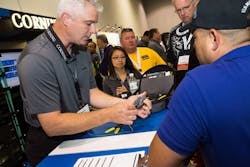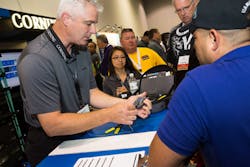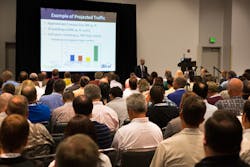Held September 16-20 at the Anaheim Convention Center in Anaheim, Calif., the BICSI 2012 Fall Conference drew more than 4,000 attendees, exhibitors, and visitors. At the educational sessions and on the exhibit hall floor, IT professionals contemplated the shift from the traditional wired world to a post-PC-cloud computing era in which wireless mobile devices are increasingly considered in network upgrades and additions. This means we can look forward to a change from a hardwired, location-based PC environment to a person-based, wireless device environment. As a result, IT professionals must be ready to rapidly evolve mobile applications and interfaces to meet sharp increases in demand.
At the same time, with this increased bandwidth demand for phone, e-mail, text, and other communications capabilities on mobile devices, the use of a distributed antenna system (DAS) within a building is gaining application. The DAS can be either a proprietary system, (designed and installed by a carrier for its own subscribers) or a vendor-neutral system (neutral host) that serves all carriers, which is a common strategy for large conference centers and stadiums. Similar to Wi-Fi technology, the system must take into account signal propagation on each floor, the building structure, and the fact that energy-efficient window glass (using low-emissivity glass coatings) can block or impede incoming signals from a cell tower.
The past two years has also seen a dramatic growth in the use of Gigabit Passive Optical Networks (GPON) technology for the commercial and government markets. GPON is the business version of the Fiber-to-the Home (FTTH) solution, which started several years ago. The ITU G.987 Standard for 10 GPON was passed in June 2010, and a recent addendum to the TIA 568-C, “Commercial Building Telecommunications Cabling Standard,” includes material on a GPON network. This standards-based technology saves energy, meets environment goals, lowers equipment and installation costs, and supports bandwidth expansion.
In a PON, an optical network terminal (ONT) or a workgroup terminal (WGT) is either a desktop or a closet-based unit that terminates a single-mode optical fiber with a number of options, such as 10/100/1000BaseT Ethernet connectivity. The PON technology uses wave division multiplexing (WDM) to transmit upstream and downstream data on different wavelengths. The GPON technology can be upgraded with a new card in the optical line terminal. A number of manufacturers featured GPON equipment and services at their booths, offering this technology as an alternative to the traditional Ethernet copper-based local area network (LAN) architecture, because a campus application of a GPON system can support up to 20,000 users.
The economic climate is not slowing the demand for data center services, whether it is in-house or outsourced. While the rules and requirements regarding access, safety, and certification regulations make in-house operation of a data center increasingly burdensome, the rising energy consumption, certification requirements, and uptime expectations are also a major concern. For that reason, the latest server rack system designs use hot aisle/cold aisle containment systems, chimney cabinets (vertical exhaust ducts), and air dams to increase cooling efficiency. There is also a growing effort to keep cable pathways neat, because they impact cooling efficiency — not just appearance and cabling system maintenance.
Data centers are also shifting rapidly to a fiber-optic cabling infrastructure, although the copper cabling industry is working on new cabling designs to support faster speeds between server racks and storage devices. Another important concern is the need for data protection and the maintenance of auditable records of physical and electronic access. Thus, software-controlled locks with PIN codes, radio frequency identification cards (RFID), and biometric identification will be required. In response to these needs, over the last few years, enterprise IT specialists have been turning to data center infrastructure management (DCIM) solutions, which include infrastructure management, optimization of environment conditions, improved power consumption, monitoring and control, and intelligent physical-layer infrastructure management.
The new Sustainable Technology Environments Program (STEP), which offers an alternative to the U.S. Green Buildings Council’s Leadership in Energy and Environmental Design (LEED) rating system, is gaining attention for use in data center projects. The program can help contractors and owners plan, design, integrate, and operate the complex equipment of a data center while reducing the project’s environmental impact.
Educational sessions
In “Updating the TIA & ISO Data Center Standards to Reflect Industry Changes,” Jonathan Jew, J&M Consultants, Inc., San Francisco, described the changes to TIA and ISO data center standards aimed at accommodating emerging technologies and data center owner needs. The new version of TIA-942 (TIA-942-A), “Telecommunication Information Standard for Data Center,” also encompasses and harmonizes with ANSI/BICSI-002, “Data Center Design and Implementation Best Practices,” and with two ISO standards. Some content, such as grounding and bonding along with administration and labeling, is transferred to other specific standards. There are several notable changes here. The LC fiber connector is specified for up to two fibers, the MPO connector is for more than two fibers, and the 100-m channel length limit for horizontal run of fiber is eliminated. OM3 (50/125 micron laser optimized) is the minimum permitted, while OM4 fiber is recommended in order to support higher performance data center switch fabrics.
The TIA update also addresses the developing next-generation balanced twisted-pair cabling standard. A new section devoted to energy efficiency also includes a three-level lighting protocol, addressed by zone, with LED lighting recommended.
In “Distributed Antenna Systems – Requirements, Approach and Current Market Trends,” Ahmed Al Taie, Thinkbox Technology Group, Irvine, Calif., described the need to support the growing use of smartphones, tablets, and other devices along with the need to satisfy public safety requirements for E911 — location accuracy. The presentation reviewed cost estimating, specification gathering, network layout based on building type and occupancy, and how to build a business case. Designers and wireless operators can choose from a variety of power levels and other features to maximize coverage and quality while optimizing cost. For example, in a high-rise building, capacity and coverage can be assured by creating a distribution system that allows each floor to share the capacity of other floors.
In “BICSI ESS Standards Update: Addressing Unique ESS Connectivity Methodology and Installation Challenges,” Carol Everett Oliver, Berk-Tek, New Holland, Pa.; Robert Jensen, Fluke Networks, Austin, Texas; and Robert Bellassai, Underwriters Laboratories, Melville, N.Y., reviewed the ANSI/BICSI 005D (draft), “Electronic Safety and Security (ESS) Information Technology System (ITS) Design and Implementation Best Practices,” standard, which has an expected publication date of January 2013. The document focuses on structured cabling for all types of security equipment, and provides a reference on common design practices that can assure the proper cabling and pathways for any type of structure. This presentation showed the challenges involved in powering devices located at extended distances, the use of composite cabling for Power-over-Ethernet (PoE) applications, cable testing, and warranty issues.
In “The Foundations for Intelligent Infrastructure Design,” Jennifer Roback, CommScope, Los Angeles, reviewed the value of a hardware and software package that can manage the ports and patch cords in a data center without the need, for example, to physically trace each patch cord and relocate them individually in case of a failure in the blade of a core switch. By using the software program, a technician would be able to press the “trace” button on the patch panel and quickly identify the other ends of the cords without the need to manually trace each cord.
In “Wireless Impact to Structured Cabling Systems,” Robert Kenny, General Cable, Highland Heights, Ky., explained that the available bandwidth per wireless user in a typical office in nearing 100 Mbps. And the move toward copper-based Gigabit switches with PoE and PoE+ capability has paved the way for even higher bandwidth, along with advances toward 802.11n and 802.11ac transmission technologies. For these reasons, wireless is a desired option for many employees, although there is a resistance to being totally reliant on wireless access. The presentation also mentioned that PoE has added a new dimension for maintaining the desktop connection. Not only has the installation of category cable continued to resist decline, but it could also grow in the years ahead.
In “A Critical Facility Roadmap – Where Eco Meets Availability,” Mark Welsko, WES, Blue Bell, Pa., emphasized the need to balance efficiency, sustainability, and availability in data center design. Especially important is the consideration of “cloud” applications in security, including access control, video surveillance, intrusion detection, and visitor management. The migration to the cloud eliminates software, servers, and the need for on-site storage, leaving only the network, cameras, and edge devices to maintain. Different types of cloud partners can assist in developing a project. Electronic access control, in particular, has shifted from a propriety system to standards-based category cabling, PoE and IP-based cameras, overtaking analog video as the dominant deployment model for surveillance.
In “Where Networks Meet – New Business Opportunities in the Cloud,” Steve Van Till, Brivo Systems, LLC, Bethesda, Md., helped attendees see the business opportunities created by the migration of physical security system — access control and video surveillance — to the cloud. The ease of connecting security applications to cloud service providers has opened this market even more than the earlier move to IP.
About the Author
Joseph R. Knisley
Lighting Consultant
Joe earned a BA degree from Queens College and trained as an electronics technician in the U.S. Navy. He is a member of the IEEE Communications Society, Building Industry Consulting Service International (BICSI), and IESNA. Joe worked on the editorial staff of Electrical Wholesaling magazine before joining EC&M in 1969. He received the Jesse H. Neal Award for Editorial Excellence in 1966 and 1968. He currently serves as the group's resident expert on the topics of voice/video/data communications technology and lighting.



